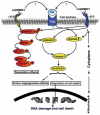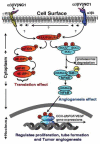Signaling mechanisms of endogenous angiogenesis inhibitors derived from type IV collagen
- PMID: 19936090
- PMCID: PMC2759143
- DOI: 10.4137/grsb.s345
Signaling mechanisms of endogenous angiogenesis inhibitors derived from type IV collagen
Abstract
Vascular basement membrane (VBM) derived molecules are regulators of certain biological activities such as cell growth, differentiation and angiogenesis. Angiogenesis is regulated by a systematic controlled balance between VBM derived antiangiogenic factors and proangiogenic growth factors. In the normal physiological state, equilibrium is maintained between the antiangiogenic and proangiogenic factors. The antiangiogenic factors (molecules), which are generated by the proteolytic cleavage of the VBM, include; alpha1 chain non-collagenous (NC1) domain of type XVIII collagen (endostatin) and the NC1 domains from the alpha chains of Type IV collagen considered as endogenous angiogenesis inhibitors. These collagen derived NC1 domains have a pivotal role in the regulation of tumor angiogenesis, thus making them attractive alternate candidates for cancer therapies. In this review we illustrate a comprehensive overview of the knowledge gained from the signaling mechanisms of Type IV collagen derived endogenous inhibitors in angiogenesis.
Figures



References
LinkOut - more resources
Full Text Sources

